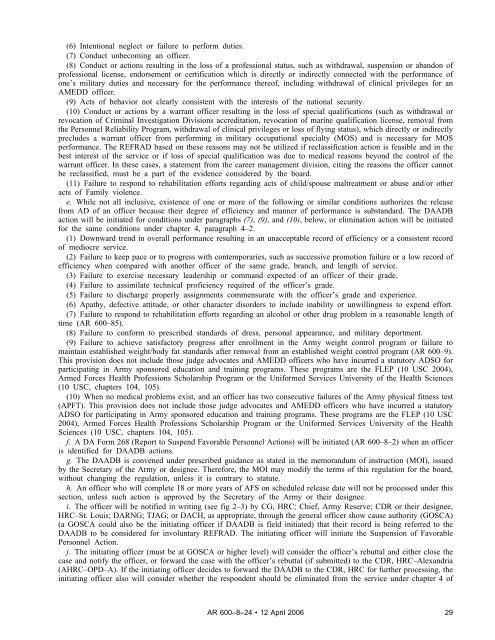Officer Transfers and Discharges - Army Publishing Directorate ...
Officer Transfers and Discharges - Army Publishing Directorate ...
Officer Transfers and Discharges - Army Publishing Directorate ...
Create successful ePaper yourself
Turn your PDF publications into a flip-book with our unique Google optimized e-Paper software.
(6) Intentional neglect or failure to perform duties.<br />
(7) Conduct unbecoming an officer.<br />
(8) Conduct or actions resulting in the loss of a professional status, such as withdrawal, suspension or ab<strong>and</strong>on of<br />
professional license, endorsement or certification which is directly or indirectly connected with the performance of<br />
one’s military duties <strong>and</strong> necessary for the performance thereof, including withdrawal of clinical privileges for an<br />
AMEDD officer.<br />
(9) Acts of behavior not clearly consistent with the interests of the national security.<br />
(10) Conduct or actions by a warrant officer resulting in the loss of special qualifications (such as withdrawal or<br />
revocation of Criminal Investigation Divisions accreditation, revocation of marine qualification license, removal from<br />
the Personnel Reliability Program, withdrawal of clinical privileges or loss of flying status), which directly or indirectly<br />
precludes a warrant officer from performing in military occupational specialty (MOS) <strong>and</strong> is necessary for MOS<br />
performance. The REFRAD based on these reasons may not be utilized if reclassification action is feasible <strong>and</strong> in the<br />
best interest of the service or if loss of special qualification was due to medical reasons beyond the control of the<br />
warrant officer. In these cases, a statement from the career management division, citing the reasons the officer cannot<br />
be reclassified, must be a part of the evidence considered by the board.<br />
(11) Failure to respond to rehabilitation efforts regarding acts of child/spouse maltreatment or abuse <strong>and</strong>/or other<br />
acts of Family violence.<br />
e. While not all inclusive, existence of one or more of the following or similar conditions authorizes the release<br />
from AD of an officer because their degree of efficiency <strong>and</strong> manner of performance is subst<strong>and</strong>ard. The DAADB<br />
action will be initiated for conditions under paragraphs (7), (9), <strong>and</strong> (10), below, or elimination action will be initiated<br />
for the same conditions under chapter 4, paragraph 4–2.<br />
(1) Downward trend in overall performance resulting in an unacceptable record of efficiency or a consistent record<br />
of mediocre service.<br />
(2) Failure to keep pace or to progress with contemporaries, such as successive promotion failure or a low record of<br />
efficiency when compared with another officer of the same grade, branch, <strong>and</strong> length of service.<br />
(3) Failure to exercise necessary leadership or comm<strong>and</strong> expected of an officer of their grade.<br />
(4) Failure to assimilate technical proficiency required of the officer’s grade.<br />
(5) Failure to discharge properly assignments commensurate with the officer’s grade <strong>and</strong> experience.<br />
(6) Apathy, defective attitude, or other character disorders to include inability or unwillingness to expend effort.<br />
(7) Failure to respond to rehabilitation efforts regarding an alcohol or other drug problem in a reasonable length of<br />
time (AR 600–85).<br />
(8) Failure to conform to prescribed st<strong>and</strong>ards of dress, personal appearance, <strong>and</strong> military deportment.<br />
(9) Failure to achieve satisfactory progress after enrollment in the <strong>Army</strong> weight control program or failure to<br />
maintain established weight/body fat st<strong>and</strong>ards after removal from an established weight control program (AR 600–9).<br />
This provision does not include those judge advocates <strong>and</strong> AMEDD officers who have incurred a statutory ADSO for<br />
participating in <strong>Army</strong> sponsored education <strong>and</strong> training programs. These programs are the FLEP (10 USC 2004),<br />
Armed Forces Health Professions Scholarship Program or the Uniformed Services University of the Health Sciences<br />
(10 USC, chapters 104, 105).<br />
(10) When no medical problems exist, <strong>and</strong> an officer has two consecutive failures of the <strong>Army</strong> physical fitness test<br />
(APFT). This provision does not include those judge advocates <strong>and</strong> AMEDD officers who have incurred a statutory<br />
ADSO for participating in <strong>Army</strong> sponsored education <strong>and</strong> training programs. These programs are the FLEP (10 USC<br />
2004), Armed Forces Health Professions Scholarship Program or the Uniformed Services University of the Health<br />
Sciences (10 USC, chapters 104, 105).<br />
f. A DA Form 268 (Report to Suspend Favorable Personnel Actions) will be initiated (AR 600–8–2) when an officer<br />
is identified for DAADB actions.<br />
g. The DAADB is convened under prescribed guidance as stated in the memor<strong>and</strong>um of instruction (MOI), issued<br />
by the Secretary of the <strong>Army</strong> or designee. Therefore, the MOI may modify the terms of this regulation for the board,<br />
without changing the regulation, unless it is contrary to statute.<br />
h. An officer who will complete 18 or more years of AFS on scheduled release date will not be processed under this<br />
section, unless such action is approved by the Secretary of the <strong>Army</strong> or their designee.<br />
i. The officer will be notified in writing (see fig 2–3) by CG, HRC; Chief, <strong>Army</strong> Reserve; CDR or their designee,<br />
HRC–St. Louis; DARNG; TJAG; or DACH, as appropriate, through the general officer show cause authority (GOSCA)<br />
(a GOSCA could also be the initiating officer if DAADB is field initiated) that their record is being referred to the<br />
DAADB to be considered for involuntary REFRAD. The initiating officer will initiate the Suspension of Favorable<br />
Personnel Action.<br />
j. The initiating officer (must be at GOSCA or higher level) will consider the officer’s rebuttal <strong>and</strong> either close the<br />
case <strong>and</strong> notify the officer, or forward the case with the officer’s rebuttal (if submitted) to the CDR, HRC–Alex<strong>and</strong>ria<br />
(AHRC–OPD–A). If the initiating officer decides to forward the DAADB to the CDR, HRC for further processing, the<br />
initiating officer also will consider whether the respondent should be eliminated from the service under chapter 4 of<br />
AR 600–8–24 12 April 2006<br />
29
















